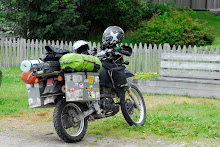 Our ride out of the coffee valley
Our ride out of the coffee valley Coffee Seedlings before being transplanted to the mountain side
Coffee Seedlings before being transplanted to the mountain side The coffee plantation at 1300 meters where Arabrica beans grow.
The coffee plantation at 1300 meters where Arabrica beans grow. Right hand has low grade beans, left hand has high grade and low grade comparison and also the white husk removed from the bean.
Right hand has low grade beans, left hand has high grade and low grade comparison and also the white husk removed from the bean.
Julie beside a heavily fruiting coffee tree with ripe red beans ready for picking. Men pick between 100 and 150 Kg of beans in a 9 hour day.
Wolfgang, the owner of the Hostel Monalisa (originally from Germany) where we`ve been staying suggested that we take a coffee plantation tour at a near by coffee farm. Wolfgang arranged a friend of his to escort us by motorcycle to the farm some 30 km from the hostel up a steep twisty highway and down a steep dirt road. Gonzales (the escorter) pointed to us where to park the bike, we abided and followed him down a dirt path and across a river and up to a manicured property owned by the coffee growers.
Gonzales dialed a number on his cellular to let the people know that we were there. The property was completly gated in as the owner used to be the governer of the region and thus required security. Once inside we were brewed a fresh cup of coffee right off the plantation. The coffee was served in a very small cup but was delicious nonetheless.
Once we were ready Alexander (our Guide) took us up an ascent into the coffee plantation. Here he began his interpretative tour and described the plantation process where by coffee seedlings were planted from seed and incubated for 10 weeks. Following ten weeks the plants were removed from their sandy soils and placed in a plastic pot for 10 months before being planted. The coffee plants were approximately 3-5 feet in height and had trunk diameters of 1.5 to 2 inches. Every 6 years the coffee plant was hacked down as its seed producing potential wained compared to its former productive years.
At altitudes greater than 800 meters Arabrica beans are grown. They produce coffee with a lower caffiene content and a better flavor. The premium beans from this region are typically shipped to Japan. So if you are jonesing for a good cup of joe apparently you gotta head to J.A-PAN Company. As for the rest of us we get the the 2nd grade beans and the Colombians enjoy the 4th grade which has bug infested and unripe beans ground into the evil elixor.
Following the coffee tour we were treated to fresh Mango juice and sat at a huge table whose deck was fashoned from a single trunk of some tree called an ear tree. The slab of wood was 4 feet wide and 6 feet long and 8 inches thick. I reckon that the tree from which this table top was cut must have been about 10 feet in diameter at breast height.
After our 3 hour walk around the plantation in the searing heat we were pooped and headed back to our hostel Monalisa for R&R.
Tomorrow we head out of Santagueda (Rochela) and possibly head to Cali. We bought two bags of coffee so we`ll brew that up at an early hour and ride south making our way towards Ecuador in the coming days.

Julie I noticed a ring on your left hand? Care to share?
ReplyDeleteOooh Julie can you bring some of those premium beans home with you for our night shifts? ;)
ReplyDeleteJULIE!!!!!!! How could you post a pick of a ringed lt hand and not comment on it??? You guys are killing us! And I agree with Mel....smuggle us some good coffee!!!!
ReplyDelete